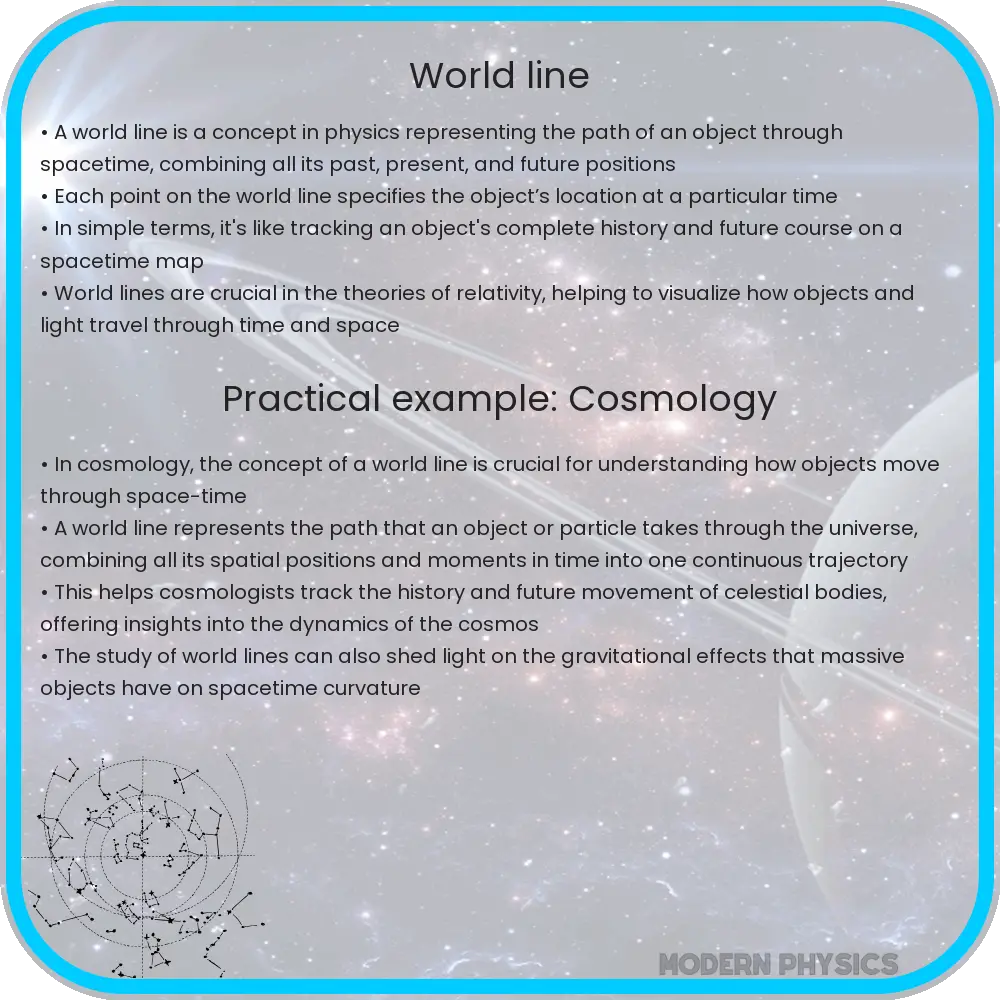Explore the fascinating world of special relativity, space-time, and causality through the lens of world lines, a key concept in modern physics.

Understanding World Lines in the Realm of Special Relativity
The concept of a world line is central to understanding the intricate dance of space, time, and causality in the realm of special relativity, a theory formulated by Albert Einstein in 1905. This theory revolutionized our understanding of the physical universe, challenging the traditional notions of absolute time and space. World lines serve as a tool to visualize and comprehend the complex interplay between these elements.
Special Relativity: A Brief Overview
Special relativity is predicated on two fundamental postulates: the constancy of the speed of light in a vacuum and the principle of relativity, which states that the laws of physics are the same for all observers in uniform motion relative to one another. This theory introduces a new framework for understanding how motion affects the perceptions of space and time.
Space-Time: The Fabric of the Universe
One of the groundbreaking implications of special relativity is the concept of space-time. This four-dimensional continuum melds the three dimensions of space with the dimension of time, creating a unified fabric where events occur. The key insight is that time, much like the spatial dimensions, is relative and can vary depending on the observer’s state of motion.
Defining World Lines
Within this space-time fabric, a world line is a path that represents the history of an object as it moves through space-time. Each point on a world line corresponds to a specific event in space and time (such as the location and time of an object at a particular moment). For stationary objects, the world line is a straight vertical line in space-time diagrams, indicating no spatial movement but progression in time. For moving objects, the world line tilts, reflecting their motion through space over time.
The Role of Light in World Lines
A pivotal aspect in the context of world lines is the role of light. In space-time diagrams, the path of a light beam is represented at an angle of 45 degrees, reflecting the constant speed of light. This angle becomes a critical factor in understanding the limitations of causality and the interrelation of events in special relativity.
In summary, world lines in special relativity offer a powerful means to visualize and comprehend the dynamics of space, time, and motion. They illustrate how different observers, moving relative to each other, can perceive the timing and sequencing of events differently, underscoring the relative nature of time and space.
Causality and the Light Cone
A crucial concept in the realm of world lines and special relativity is the light cone. This structure, visualized in space-time diagrams, demarcates the boundary within which causal relationships between events can occur. The light cone is divided into two regions: the future light cone and the past light cone. Events within the future light cone can be influenced by a given event, while events within the past light cone can have an effect on it. This segregation is crucial as it adheres to the principle that no influence can travel faster than light, ensuring causality is maintained.
Relative Simultaneity and its Implications
Another fascinating outcome of world line analysis is the concept of relative simultaneity. In classical physics, two events occurring simultaneously are simultaneous for all observers. However, special relativity disrupts this notion. Depending on the observer’s frame of reference, especially when moving at speeds close to that of light, events that appear simultaneous in one frame may occur in a different chronological order in another. This phenomenon is a direct consequence of the way world lines intersect or diverge in the space-time continuum.
World Lines in Practical Application
While world lines are a theoretical construct, they find practical application in various fields, including astrophysics, particle physics, and cosmology. They help scientists predict the trajectories of celestial bodies, analyze the behavior of particles in accelerators, and understand the evolution of the universe. The concept also has intriguing implications in the field of time travel theories, although such applications remain in the realm of speculation and theoretical physics.
Conclusion
In conclusion, world lines in the context of special relativity provide a profound and nuanced understanding of the universe’s structure. They illustrate how space and time are interwoven, how motion affects our perception of these dimensions, and how causality governs the interrelationships of events. The concept of world lines not only challenges our intuitive understanding of time and space but also lays the groundwork for modern physics’ theories and explorations. As a cornerstone of special relativity, world lines continue to intrigue and inspire both scientists and enthusiasts alike, inviting us to delve deeper into the mysteries of the cosmos.
